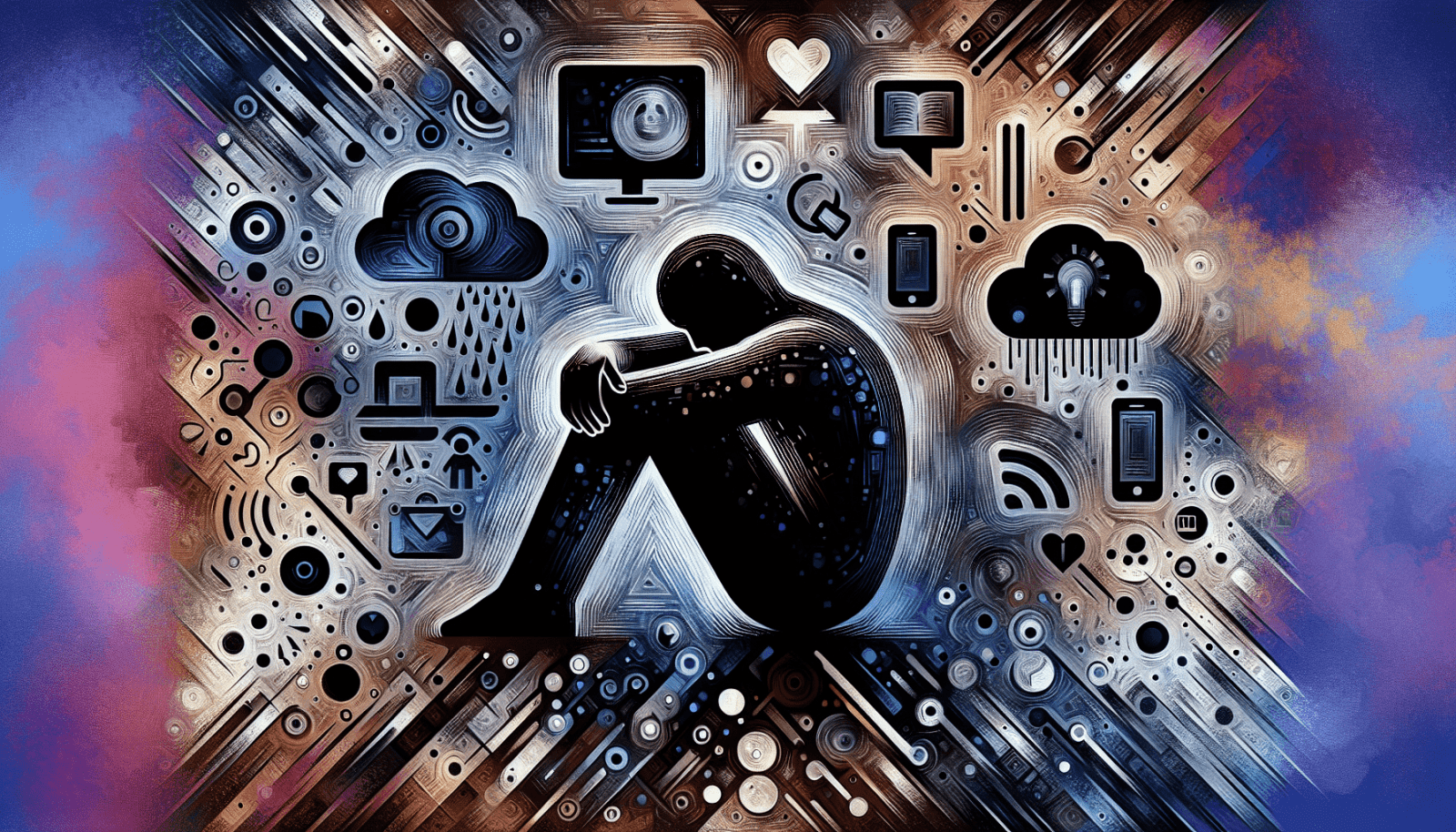In today’s digital age, where social media platforms and online interactions have become an integral part of our lives, it is crucial to acknowledge the detrimental effects of cyberbullying on mental health. This article aims to shed light on the often overlooked consequences of cyberbullying, exploring how it can severely impact individuals’ emotional well-being and psychological state. By understanding the lasting impact of cyberbullying, we can work towards creating a safer and more compassionate online environment for everyone.

Definition of Cyberbullying
Introduction to Cyberbullying
Cyberbullying refers to the act of using technology, such as smartphones, social media platforms, or instant messaging, to harass, intimidate, or humiliate others. Unlike traditional bullying, which typically occurs face-to-face, cyberbullying takes place in the digital realm, allowing perpetrators to remain anonymous and distance themselves from the consequences of their actions.
Types of Cyberbullying
There are various forms of cyberbullying, each with its own unique characteristics and impact on the victims. Examples include:
- Verbal Abuse: This involves sending threatening or derogatory messages, spreading rumors, or engaging in online name-calling.
- Exclusion and Social Manipulation: Perpetrators deliberately exclude individuals from online groups, chats, or activities, often causing feelings of isolation and alienation.
- Embarrassment and Public Shaming: Sharing private or embarrassing information, photos, or videos with the intention of mocking, humiliating, or embarrassing the victim.
- Impersonation and Identity Theft: Creating fake accounts or masquerading as the victim to spread false information or engage in harmful activities.
- Cyberstalking: Persistent and unwanted online harassment, in which the perpetrator obsessively tracks and monitors the victim’s activities.
Examples of Cyberbullying
Cyberbullying can manifest in numerous ways, leaving victims emotionally scarred and psychologically distressed. Some examples of cyberbullying include:
- Online Harassment: Receiving threatening or offensive messages, comments, or emails on various digital platforms.
- Hate Speech: Experiencing targeted attacks based on one’s race, religion, gender, sexual orientation, or other personal characteristics.
- Public Shaming: Having personal information, photos, or videos shared publicly without consent, leading to humiliation and shame.
- Blackmail: Being subjected to threats of revealing personal or embarrassing information unless certain demands are met.
- Trolling: Receiving inflammatory or provocative comments designed to provoke an emotional response or create conflict.
Prevalence of Cyberbullying
Statistics on Cyberbullying
Cyberbullying has become increasingly prevalent in recent years, affecting people of all ages and backgrounds. According to research conducted by the National Center for Education Statistics, approximately 20% of students in the United States have experienced cyberbullying at some point. Furthermore, a survey conducted by the Cyberbullying Research Center revealed that around 34% of students in grades 6-12 have been victims of cyberbullying.
Age Groups Affected by Cyberbullying
While individuals of all age groups can fall victim to cyberbullying, certain age groups are more susceptible due to their level of digital literacy and online presence. Adolescents and teenagers are particularly vulnerable, as they often spend a significant amount of time online and may be more prone to engaging in risky behaviors. However, adults, especially those who actively participate in social media platforms, are not immune to cyberbullying and can also be targeted.
Frequency and Duration of Cyberbullying
Cyberbullying incidents can vary in frequency and duration, depending on several factors, including the severity of the situation and the actions taken by the victim and authorities. Some victims may experience repetitive instances of cyberbullying, with attacks occurring on a daily or weekly basis. Additionally, cyberbullying can have long-term effects, as the digital nature of the harassment allows for the spread of harmful content that can persist indefinitely.
Effects of Cyberbullying on Mental Health
Emotional Impact of Cyberbullying
Cyberbullying can have a profound emotional impact on victims, leading to feelings of sadness, anger, fear, and helplessness. The relentless nature of online attacks can cause constant stress and anxiety, leading to a decline in overall emotional well-being. Victims often experience feelings of embarrassment, shame, and humiliation, which can erode their self-esteem and sense of self-worth.
Psychological Impact of Cyberbullying
The psychological impact of cyberbullying can be severe and long-lasting. Victims may develop symptoms of depression, experiencing persistent feelings of sadness, hopelessness, and loss of interest in activities they once enjoyed. Anxiety disorders, such as generalized anxiety disorder or social anxiety disorder, may also develop as a result of the constant fear and anticipation of online attacks. Additionally, victims may develop symptoms of post-traumatic stress disorder (PTSD), which can lead to intrusive thoughts, flashbacks, and hypervigilance.
Social Impact of Cyberbullying
Cyberbullying can have a detrimental effect on an individual’s social life. Victims may become socially isolated, withdrawing from activities and relationships that were once enjoyable. The fear of further victimization may cause individuals to become distrustful of others and reluctant to engage in social interactions, leading to a sense of isolation and alienation. Additionally, cyberbullying can damage existing relationships, as false information or rumors can create discord and mistrust among friends and family.
Increased Risk of Mental Health Issues
Depression and Anxiety
The experiences of cyberbullying can significantly increase the risk of developing mental health disorders such as depression and anxiety. The constant barrage of negative and hurtful messages can erode an individual’s self-esteem and disrupt their ability to experience joy and fulfillment. The sense of isolation and fear of further victimization can contribute to the development of depressive symptoms, while the anticipation of future attacks can trigger anxiety and panic.
Low Self-Esteem and Self-Worth
Victims of cyberbullying often experience a significant decline in their self-esteem and self-worth. The repeated attacks can create a distorted self-image, as victims internalize the negative messages directed towards them. This can lead to feelings of worthlessness, self-doubt, and a loss of confidence in one’s abilities, further perpetuating the cycle of victimization.
Suicidal Ideation and Self-Harm
The psychological distress caused by cyberbullying can be overwhelming, leading some victims to contemplate self-harm or even suicide. The feelings of hopelessness, isolation, and an inability to escape from the torment can create a profound sense of despair. It is essential to recognize the severity of these risks and provide appropriate support and intervention for individuals who may be in crisis.

Cyberbullying and Academic Performance
Impaired Concentration and Focus
The impact of cyberbullying extends beyond an individual’s emotional well-being and can significantly affect their academic performance. The constant distress and preoccupation with online attacks can impair concentration and focus, making it challenging for victims to engage in their studies effectively. The persistent fear of further victimization can further disrupt their ability to concentrate, leading to a decline in academic performance.
Decline in Grades and Educational Achievement
Cyberbullying can have a direct impact on an individual’s grades and overall educational achievement. The emotional turmoil created by the attacks can lead to a loss of motivation and interest in learning, resulting in a decline in academic performance. Additionally, the social isolation and exclusion experienced by victims can limit their access to resources and support systems, further impeding their educational progress.
School Absenteeism and Dropout Rates
The negative effects of cyberbullying can be so severe that they may lead to increased rates of school absenteeism and, in some cases, even dropout rates. The fear of encountering the perpetrators at school, combined with the emotional distress caused by the attacks, can make it extremely challenging for victims to attend school regularly. The disengagement from educational settings can result in poor educational outcomes and limit future opportunities.
Long-term Effects of Cyberbullying
Post-Traumatic Stress Disorder (PTSD)
For some victims, the traumatic experiences of cyberbullying can lead to the development of post-traumatic stress disorder (PTSD). The persistent and distressing nature of the attacks can trigger symptoms such as intrusive thoughts, nightmares, hyperarousal, and avoidance behaviors. These symptoms can have a significant impact on a person’s daily functioning and overall quality of life.
Development of Physical Health Problems
The psychological toll of cyberbullying can also manifest in physical health issues. Chronic stress and anxiety caused by online attacks can lead to a weakened immune system, increasing the likelihood of developing physical illnesses such as headaches, stomachaches, and sleep disturbances. Additionally, the emotional distress may contribute to unhealthy coping mechanisms, such as overeating or engaging in substance abuse, further exacerbating physical health concerns.
Impact on Future Relationships and Social Interaction
The effects of cyberbullying can extend far beyond the immediate experiences of victimization, impacting an individual’s future relationships and social interactions. The deep-rooted trauma and mistrust resulting from cyberbullying can make it challenging for victims to form and maintain healthy relationships, including romantic partnerships, friendships, and professional connections. The fear of online attacks may lead to social withdrawal and a general reluctance to engage in new social experiences.
Cyberbullying and Stigma
Reluctance to Seek Help
Victims of cyberbullying often face significant barriers when seeking help and support. Society’s limited understanding and awareness of cyberbullying may contribute to a reluctance to report incidents or disclose their experiences. The fear of not being taken seriously or facing further victimization can leave individuals feeling isolated and without the resources they need to address the issue effectively.
Fear of Reprisals or Judgment
Fear of reprisals or judgment from others can also prevent victims from seeking help. The anonymous nature of cyberbullying can leave victims uncertain about the identities of their perpetrators, leading to concerns about potential retaliation or consequences in their personal or professional lives. Additionally, the fear of being blamed or judged for their victimization can further deter individuals from reaching out for support.
Sense of Isolation and Alienation
A common consequence of cyberbullying is the profound sense of isolation and alienation experienced by victims. The emotional and psychological turmoil can make individuals feel detached from their peers and create a deep sense of loneliness. This isolation can be particularly challenging to address, as victims may struggle to find a sense of belonging and connection without the fear of judgment or victimization.
Preventive Measures for Cyberbullying
Education and Awareness Programs
Educational institutions, parents, and communities play a crucial role in preventing cyberbullying. Education and awareness programs can teach individuals about the consequences and impact of cyberbullying, as well as provide them with strategies to prevent and address such behavior. These programs should focus on fostering empathy, promoting kindness, and teaching individuals how to use digital platforms responsibly and safely.
Promotion of Digital Literacy
Promoting digital literacy and responsible online behavior is essential to combat cyberbullying effectively. Teaching individuals about privacy settings, online etiquette, and the potential consequences of their actions can empower them to protect themselves and others from cyberbullying. By promoting digital literacy, individuals can develop the skills necessary to navigate the online world and identify potential risks and harmful behaviors.
Enforcement of Anti-Cyberbullying Policies
Schools, workplaces, and online platforms should enforce strict anti-cyberbullying policies to ensure a safe and inclusive environment. By implementing clear consequences for cyberbullying behavior, individuals are less likely to engage in such acts. It is crucial for institutions to prioritize the safety and well-being of their members and take immediate action when instances of cyberbullying occur.
Impact on Society and Communities
Burden on Healthcare Systems
The prevalence of cyberbullying places a significant burden on healthcare systems. Individuals who have been victimized may require psychological support, therapy, or counseling to address the emotional and psychological consequences of cyberbullying. The demand for mental health services increases as more people seek professional help to cope with the trauma caused by cyberbullying incidents, resulting in increased strain on healthcare resources.
Costs to Employers and Productivity Loss
In addition to the toll on individuals’ mental health, cyberbullying can also impact employers and workplace productivity. Victims who experience cyberbullying may suffer from decreased concentration, increased absenteeism, or decreased job satisfaction. These effects can result in reduced productivity and increased costs for employers due to higher training and turnover rates.
Creating Supportive Environments and Resources
Communities and organizations need to create supportive environments and resources to address the issue of cyberbullying comprehensively. This includes implementing policies that condemn cyberbullying, fostering a culture of empathy and respect, and providing accessible support systems for victims. By working together, communities can provide resources such as helplines, counseling services, and support groups to assist victims in their recovery journey.
Conclusion
Recognizing the Seriousness of Cyberbullying
Cyberbullying has emerged as a significant concern in today’s digital age, with profound implications for individuals’ mental health and well-being. It is essential to recognize the seriousness of cyberbullying and acknowledge the far-reaching impact it can have on victims’ lives.
The Importance of Intervention and Support
Immediate intervention and support are crucial in addressing cyberbullying effectively. Victims need to know that they are not alone and that there are resources available to help them navigate through the challenges they face. This may include seeking professional counseling, confiding in trusted friends or family members, or contacting local support organizations that specialize in cyberbullying.
Building Resilience and Empowering the Victims
Building resilience and empowering victims is of utmost importance when addressing cyberbullying. By providing individuals with the necessary tools to protect themselves and promoting a culture of kindness and respect, we can work towards minimizing the prevalence and impact of cyberbullying. Together, we can create a safer and more inclusive digital environment for everyone.
